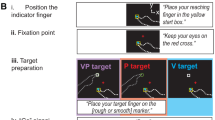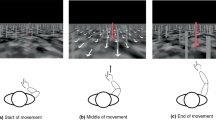Abstract
We investigated the mechanisms of sensorimotor adaptation by sequentially exposing human subjects to different visual distortions. Subjects performed a manual tracking task, while the relationship between their actual finger movement and its visual feedback was manipulated either by a position-to-position (PP), or by a position-to-velocity (PV) transformation. The outcome confirmed previous findings, in that adaptation to PP facilitated the subsequent adaptation to a second, additional PP. More importantly, our present data documented that pre-exposure to PP interferes with the subsequent adaptation to PV, and vice versa. Thus, we observed anterograde interference between two transformations of common physical nature (i.e., visual), but different kinematic coupling. When previous work on sequential adaptation to visual and mechanical transformations is reconsidered in light of this finding, converging evidence is yielded in favor of a distributed adaptive mechanism, where the magnitude of interference between two successive adaptation sessions depends on the overlap of the involved neural structures.


Similar content being viewed by others
References
Abeele S, Bock O (2001) Mechanisms for sensorimotor adaptation to rotated visual input. Exp Brain Res 139:248–253
Bock O, Schneider S, Bloomberg J (2001) Conditions for interference versus facilitation during sequential sensorimotor adaptation. Exp Brain Res 138:359–365
Brashers-Krug T, Shadmehr R, Bizzi E (1996) Consolidation in human motor memory. Nature 382:252–255
Flanagan JR, Nakano E, Imamizu H, Osu R, Yoshioka T, Kawato M (1999) Composition and decomposition of internal models in motor learning under altered kinematic and dynamic environments. J Neurosci 19:1–5
Krakauer JW, Ghilardi M-F, Ghez C (1999) Independent learning of internal models for kinematic and dynamic control of reaching. Nat Neurosci 2:1026–1031
Lazar G, Laer J van (1968) Adaptation to displaced vision after experience with lesser displacements. Percept Mot Skills 26:579–582
Shadmehr R, Brashers-Krug T (1997) Functional stages in the formation of human long-term motor memory. J Neurosci 17:409–419
Tong C, Wolpert D, Flanagan J (2002) Kinematics and dynamics are not represented independently in motor working memory: evidence from an interference study. J Neurosci 22:1106–1113
Acknowledgements
Thanks are due to I. Benick for software development, and to V. Kupilas and H. Sprick for help with subject testing. This study was supported by grant BO 649/8 from the DFG, and grant 50WB9547 from the German Ministry of Education and Research. Responsibility for the content rests with the authors.
Author information
Authors and Affiliations
Corresponding author
Rights and permissions
About this article
Cite this article
Bock, O. Sensorimotor adaptation to visual distortions with different kinematic coupling. Exp Brain Res 151, 557–560 (2003). https://doi.org/10.1007/s00221-003-1553-y
Received:
Accepted:
Published:
Issue Date:
DOI: https://doi.org/10.1007/s00221-003-1553-y




